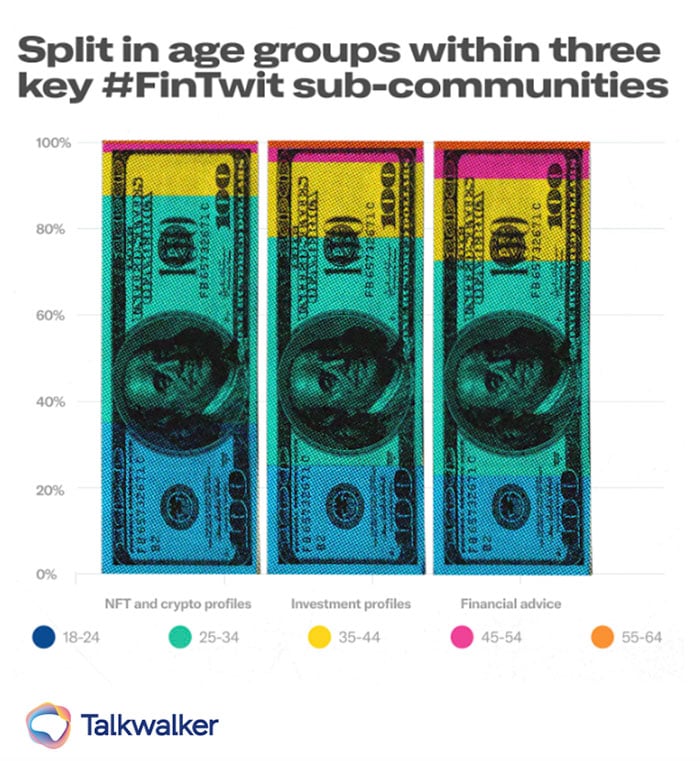What is FinTwit?
FinTwit is a lot of things: It's a hashtag. It's a community. It's a trend. It's an issue. And it's something that brands should pay attention to. We'll get into exactly why later. But first, the data.
A graph from the report shows that younger audiences are more interested in topics such as NFT and cryptocurrency, while older audiences are looking for investment and financial advice.
In the full report, we unveil some compelling figures about this growing community, made up of a diverse set of tweeters posting about finance topics. From August 2021 to August 2022, we observed the following growth metrics within this community:
- +102% in Asia
- +19.7% in North America
- +57.3% in Europe
And these market news hounds are trending younger than you might expect. The report lines up detailed demographic data around age and region to reveal key motivators in those segments. For example, 35% of the users joining the conversation in Asia over the last year are 18- 24 years old, driven by the boost in cryptocurrency. Though FinTwit isn't just for younger audiences, the data shows that an individual's reasons for joining the community are most likely influenced by age and location.
What's driving the trend?
As it turns out, nothing draws a crowd like a crisis. The fluctuating state of the economy and the rising cost of living have inspired people to take a long, hard look at their personal finances. In January 2022, when inflation first started to spike, we saw a corresponding uptick in #FinTwit conversations. And that trend hasn't quieted. As the cost of living continues to take its toll around the world, more conversations about finance are happening in the Twitter feed.
Considering the anxiety this instability can cause, a high level of social media engagement makes a lot of sense. Online communities such as FinTwit help joiners feel more empowered with information. These tweeters are flocking to the community looking for market news on the best investments to make and the latest updates on promising finance models.
Good morning ladies and gentlemen let’s get after it today. Always have a game-plan, keep wins conservative and cut your losses short. On watch: $SHC $ICU $FRGT $EUDA $COSM #stockmarket #daytrader #fintwit #daytrade
— Aaron Malloch (@teambullish) November 21, 2022
What are they talking about?
We know from the content of their conversations that, rather than purely money hungry, many in this community are working towards building a financially stable future. How they plan to do that aligns, yet again, with age and location. Younger audiences are discussing more modern and technical investments, such as NFTs and cryptocurrency. In fact, that's driving 61% of the conversations on #FinTwit, compared with only 23% focused on traditional financial investments, such as stocks and bonds.
This sentiment cloud shows in pink the negative conversations around traditional finance terms.
This corresponds with the sentiment data we surfaced. The sentiment cloud published in the report shows that more traditional finance terms, such as central banks and financial institutions, have a negative connotation for this community. Those terms with a positive association show what motivates the FinTwit community most—financial freedom and a decentralized finance system. This type of sentiment analysis data distills how customers feel about specific topics, and can be leveraged to shape relevant and effective brand strategies.
Why should brands care?
People in this growing community are paying closer attention to what they're doing with their money, and they'll have a greater affinity for brands that are in alignment with that. That means brands that communicate product quality and value in a compelling way may resonate better, and build deeper connections with their customers.
The theme cloud on the left shows brands—including some high-end fashion retailers—referenced in online conversations around secondhand clothing and fashion. The cloud on the right highlights companies associated with cryptocurrency payments, including Tesla, which started accepting Dogecoin in January 2022.
Take, for example, the growing popularity and changing perception of secondhand retail. The trope, made famous by Macklemore, of digging through the bins at the Salvation Army with twenty dollars in your pocket is so-2012. Today, re-used clothing is being reclaimed as an environmentally friendly and financially responsible way to stay trendy—even big-name brand trendy.
Gap, Athleta, Madewell, Urban Outfitters, Vera Bradley, Hollister, and others have introduced rewards programs with secondhand marketplaces like Poshmark and thredUP. These programs allow customers to exchange items in their closet they aren't using for cash or credit—even the cost of shipping is usually covered.
What were formerly known as "thrift store clothes" are now often referred to as "upcycled" or "preloved"—terminologies with positive financial and environmental connotations. As a result, brands, including those in the high-end retail space, are becoming more comfortable associating with the topic.
In addition, our report research shows this audience will be increasingly drawn to brands who accept more decentralized methods of payment, like cryptocurrency.
Expedia and Travala.com joined forces in 2020 to offer travel bookings with cryptocurrency.
Companies such as Starbucks, Tesla, Expedia, and Lush have started accepting crypto as payment. You can even buy a Coke with crypto in New Zealand and Australia.
Brands that know how to speak to customers increasingly motivated by financial independence, and address their key pain points, will be positioned to win brand loyalty and increase retention.
As a Twitter Official Partner, Talkwalker is positioned to provide real-time insights that can help brands connect with this, and many other, niche online communities.
